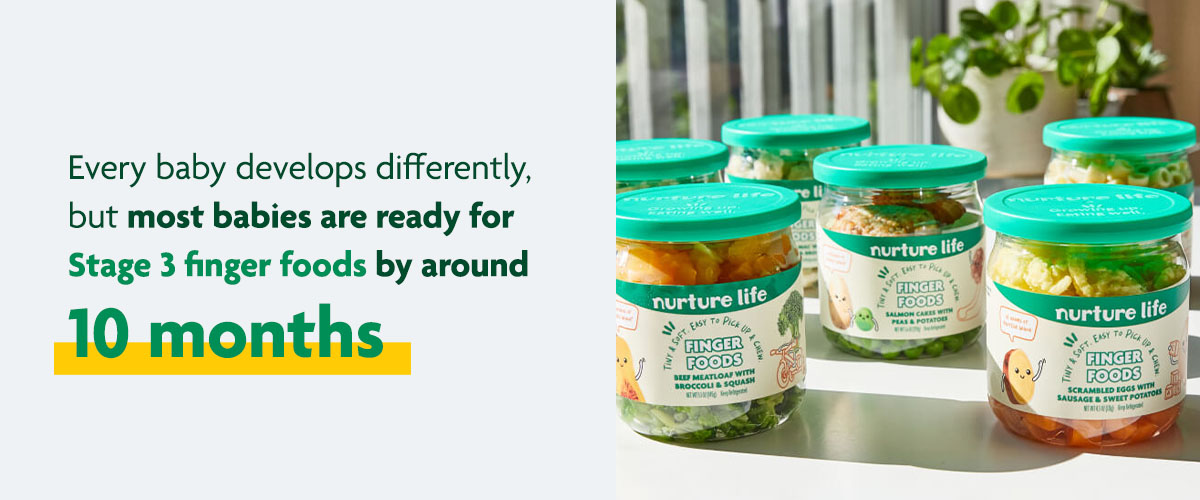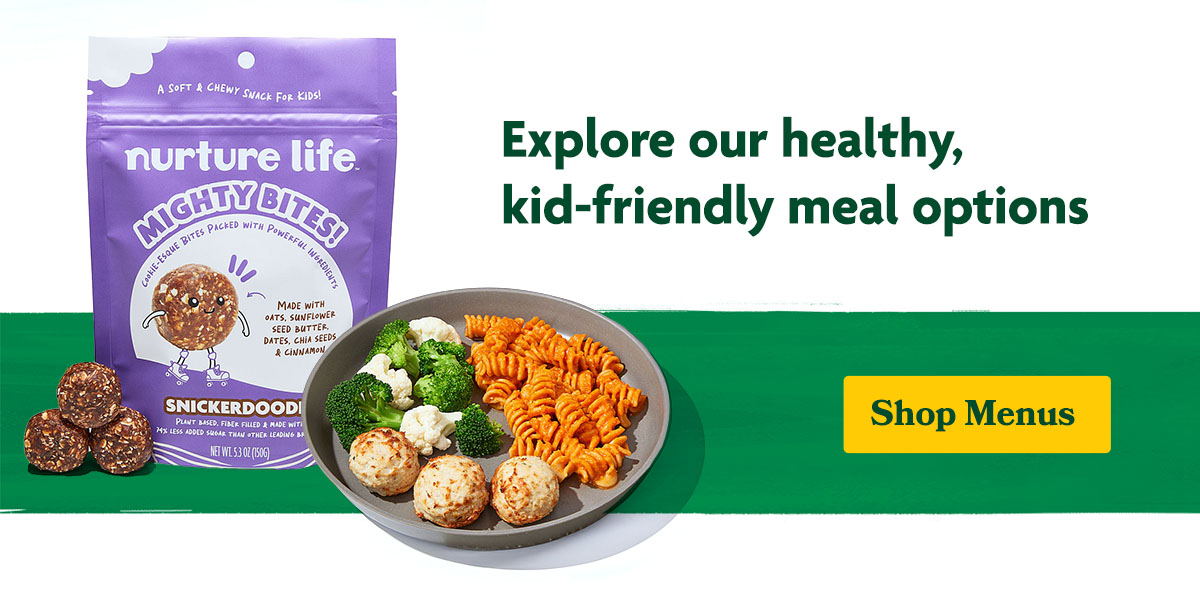Best Combo Purees for Stage 2 Baby Food
After your baby has become accustomed to Stage 1 single-ingredient purees and is ready for more sophisticated tastes and textures, it’s time to dive into Stage 2 baby food combination purees.
To ease this next step of your baby’s food adventure, we’re highlighting some of the best baby food puree combos, starting with two ingredients and then moving on to more complex blends of three ingredients and more. Stick around to the end for additional Stage 2 feeding tips from one of Nurture Life’s registered dietitians!
Start With Two-Ingredient Baby Food Combinations
Somewhere around 8–10 months of age, your baby will have adjusted to the single-ingredient purees of Stage 1 and will be ready to start Stage 2 baby foods, which are generally thicker and chunkier, while introducing new ingredients and flavors.
Before diving into all those inventive multi-ingredient blends, however, we recommend easing in with a few basic purees of only two ingredients.
Why Start With Two-Ingredient Purees?
That blackberry, kale, turkey, and quinoa puree may sound more fun (and maybe even healthier), but we like starting with simpler two-ingredient purees. It’s not a hard-and-fast rule, but focusing on two-ingredient purees can help you navigate these mealtime moments:
- Food sensitivities: By introducing only one new food at a time, you’ll be able to identify any food intolerances or allergies, including the most common “Big 8” allergens.
- Food acceptance: Too much change at once can be overwhelming for a baby who’s already changing so much every day. Focusing on small tweaks to already-accepted foods will help your baby adjust more smoothly.
- Palate development: Gradually layering new flavors and textures will help “warm up” your baby’s palate for the more advanced Stage 2 combinations.
Nutritious Ideas for Two-Ingredient Stage 2 Baby Food
As you move into Stage 2 baby food combinations, start with ingredients that your little one knows and tolerates. Keep things safe and simple by combining one already-accepted food with one new food, gradually expanding your baby’s diet one ingredient at a time.
Based on whatever your baby already likes, try out some of these two-ingredient puree ideas to get started:
- Beef & Carrot
- Banana & Avocado
- Sweet Potato & Raspberry
- Beets & Pear
- Chicken & Sweet Potato
- Zucchini & Apple
- Cauliflower & Spinach
- Pumpkin & Farro
- Green Peas & Mushrooms
- Golden Delicious Apple & Kale
- Brown Rice & Beans
- Spinach & Lentils
- Strawberry & Salmon
- Edamame & Mango
For your baby’s Stage 2 starter purees, there’s almost no two-ingredient combination you can’t try! Feel free to blend almost any fruit, veggie, grain, or protein — just as long as your purees include one ingredient your baby already accepts and remain mushy, moist, and lightly textured.
Signs That Your Baby Is Ready for Stage 2
Usually, babies 6 to 9 months old are ready for Stage 2 baby food purees. However, babies develop on their own schedules, so what works for someone else’s baby may not work for yours. As a result, you must pay attention to the cues your baby sends you to show that they’re ready to explore more complex baby food combinations.
Here are signs to look out for:
- Comfortable eating: During Stage 1, you’ll notice that your baby pushes the food out with their tongue, making the feeding process challenging. That tongue thrust reflex will begin to disappear, indicating that your child is learning to eat properly.
- Increased appetite: A few weeks or months after initiating Stage 1 foods, you may notice your baby’s appetite has increased and they seem to want more than the usual serving.
- Enjoyment: After a while, your baby may show you that they enjoy their food by eagerly awaiting every spoonful.
- Variety: If you’ve gone through all of the single Stage 1 ingredients, like fruits, vegetables, and legumes, without a hitch and the baby seems to love the journey, it’s probably time to move on to the next level.
If your baby displays some of these signs, the two of you are ready to dive into some of the best combo baby purees for Stage 2.
Add Depth With Three-Ingredient Stage 2 Baby Food
As your baby explores different food groups, colors and flavors in the form of two-ingredient purees, you can start expanding into more complex purees of three ingredients or more.
Just like the earlier two-ingredient baby food combinations, consider introducing only one new food at a time, even as the purees get more complicated. If you’re ever worried about your baby’s tolerance of a certain food due to a family history of food allergies or otherwise, we’d recommend a combo puree that contains ingredients your baby has already tried plus one new ingredient blended in. This is also a great way to introduce the Big 8 allergens (with your pediatrician’s guidance)!
Although many Stage 2 baby foods still lead with fruits and veggies, there’s so much more for your little one to explore! Expand your baby’s palate beyond the “standard stuff” with these more grown-up combination purees.
Stage 2 Purees With Whole Grains
Why not skip the quick-dissolve rice cereals and blend in some nutrient-rich whole grains? With a helping of fiber, protein, and complex carbs, whole grains are important for your baby’s energy and digestive health.
Whole Grain Puree Ideas
- Zucchini, Yam, & Farro
- Millet, Broccoli, & Carrot
- Banana, Raisin, & Oatmeal
- Chicken, Quinoa, & Pear
Stage 2 Purees With Proteins
Protein serves as the main building block of the body, helping power muscle development and transport essential nutrients for bodily processes. You’ll find good sources of protein for your baby in blends with meat, legumes or whole grains.
Protein-Packed Puree Ideas
- White Fish, Potato, & Pumpkin
- Sweet Potato, Kale, & Chickpeas
- Turkey, Sweet Potato, & Golden Beet
- Whole Milk Yogurt, Oatmeal, & Blueberries
- Sweet Potato, Pear, & Lentil
Stage 2 Purees With Herbs & Spices
Exposure to a variety of spices, herbs, and seasonings early on can help your baby learn to accept (and even like!) more foods over a lifetime. Start integrating these new ingredients and a little culinary flair into your baby’s meals to give them a good introduction to more “adult” flavors. In addition to interesting whole grains, unexpected proteins, and varied fruits and veggies, Nurture Life gives babies a palatable way to try out spices like curry, turmeric, thyme, and cinnamon.
Herb & Spice Puree Ideas
- Fennel, Peach, & Pea
- Mango, Carrot, & Ginger
- Zucchini, Mint, & Pea
- Apple, Raspberry, & Vanilla Bean
- Squash, Bell Pepper, Raisin, Couscous, & Curry
Stage 2 Purees With Fruits & Vegetables
Fruits and vegetables give your baby an excellent foundation for a healthy future. Combination baby purees containing fruits and veggies are rich in vitamins, minerals, antioxidants, and fiber, which are necessary for promoting good health and protection against illnesses. You want your baby’s immune system to start benefiting from the powerful nutrients in fruits and veggies as soon as possible. That’s why Stage 2 offers you more room for healthy and delicious combos.
Fruit & Vegetable Puree Ideas
- Broccoli, White Beans, & Apple
- Spinach, Pea, & Pear
- Butternut Squash, Apple, & Carrot
- Carrot, Cauliflower, & Banana
- Lentil, Parsnip, & Pear
- Carrot, Mango, & Banana
Your Baby Food Stage 2 FAQs, Answered
Stage 2 isn’t only about what you serve your baby. It’s also about providing and maintaining a healthy balance of nutrients so your little one is developmentally ready for Stage 3. One of Nurture Life’s registered dietitians explains more below.
Why Is Stage 2 Important?
As an intermediary step between liquid single-ingredient purees and chunkier finger foods, Stage 2 bridges the gap between your baby’s first food adventures and their future of self-feeding. It’s an important time for your little one to develop gumming, swallowing, and self-feeding skills, as well as an acceptance of varied flavors and textures.
How Do I Help Ensure My Baby Gets the Nutrients They Need?
During the first year of life, your baby’s primary source of nutrients should be breast milk and/or formula. Any supplemental food is meant to help:
- Introduce new flavors and textures to expand your baby’s palate.
- Provide additional nutrient benefits beyond breast milk or formula, such as added iron or dietary fiber.
- Give insight into your baby’s tolerance of a variety of foods.
- Teach your baby’s digestive tract to tolerate different foods.
- Help with gross motor functions associated with eating.
- Help with dexterity as they learn to self-feed.
As long as you continue to explore new foods with your baby and offer breast milk or formula, don’t worry too much about finding specific nutrients — your baby will get what they need!
What if My Baby Rejects Combo Purees?
Just like when your baby first started Stage 1 purees, they may take some time to develop a preference for new flavors and textures. Sometimes rejection means, “I’m not ready for that food yet,” and sometimes it means something else:
- “I’m teething.”
- “I’m too full from breast milk or formula.”
- “I’m constipated.”
- “I’m tired!”
It can be difficult to know exactly why your baby is rejecting a new combo puree, but the best answer is typically not to worry too much. Just give them a few days off and try again!
When Should My Baby Start Stage 3?

Every baby develops differently, but most babies are ready for Stage 3 finger foods by around 10 months. The most important cue is not a specific age but rather an interest in self-feeding, experimentation, and independence — along with key developmental capabilities like grasping and mushing. For more tips, check out our guide on transitioning to finger foods.
How Do I Know Which Ingredients Cause Allergies?
Allergies are a big concern for parents, but it’s easy to tell if your child is allergic to certain ingredients as you progress through Stage 1, where you explore single-ingredient baby food recipes.
You want to move your baby to the next stage once you’ve gone through all the food groups, focusing on one ingredient at a time and allowing your baby to adjust to each. Since you can experiment with three or more ingredients at Stage 2, introduce any new ingredient alongside those your baby already eats. That way, in case of a bad reaction, you’ll know the culprit.
What’s the Consistency of Stage 2 Baby Food?
In terms of texture, Stage 2 purees aren’t that different from Stage 1. They should be slightly thicker than Stage 1 but pureed instead of mashed. You can achieve the necessary consistency by blending your combination with less water.
What if the Texture Is Too Thick?
Usually, you’ll want to have some leftover water from draining your ingredients after cooking. Add it directly to the food while stirring until you’re satisfied with the texture. Alternatively, you can use plain boiled water, formula, or breastmilk to thin your baby’s food.
Find Healthy Baby Meals, Tips, and Resources at Nurture Life

As you enter and move through Stage 2, the best baby food combinations will add a whole new world of excitement to your baby’s high chair tray. By layering new ingredients slowly, you can help your little one learn to love various flavors and textures while getting important nutrients for growth.
If you have any questions about supporting your baby’s eating journey through Stage 2 and 3 foods, contact Nurture Life’s child nutrition experts today!
